Don't wanna be here? Send us removal request.
Text
Ikebana Iridescence
Ikebana Iridescence.
I’ve kept this concept in the vault of my ideas for years - combining light with floral arrangements. The art of ikebana was always inspiring. The practice of using natural, found elements in a poetic and sculptural way. With that in mind, I’ve wanted to combine my use of light with it. For years, sketchbook after sketchbook, I’d write in “ikebana! with lights!” but never found it was the right time or even how to execute it. But sometimes you just have to do it and see where it takes you.
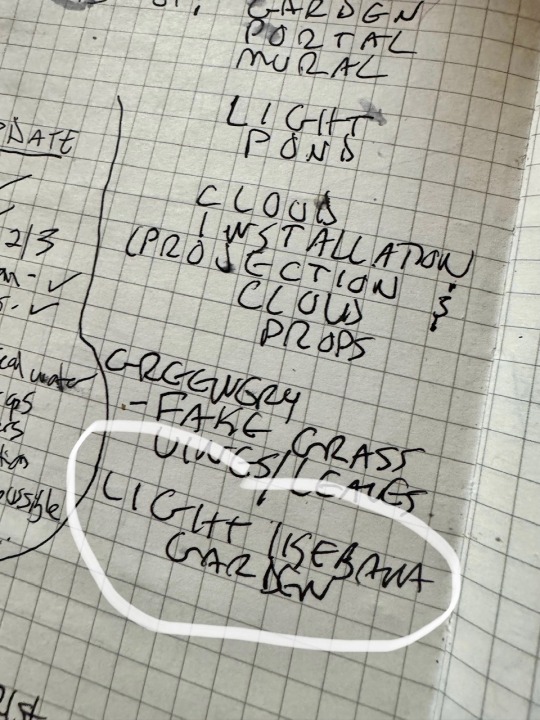
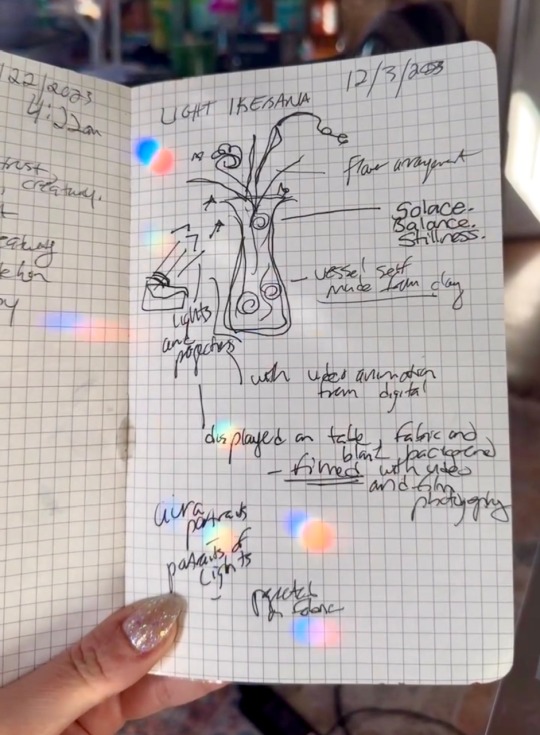
There are many similar sketches and mentions, but just for the process sake these are the more recent ones.
In a way I’ve already frequented the combination of plants and lights - projection mapping on them as well. So the concept isn't entirely new.

This is a shot as part of an immersive light installation I did for ArtFair14c one year, that I titled "Garden Reverie." But those flowers were fake, of course. Just a reoccurring prop I use as well as my acrylic tubes and random glass boxes I come across. I feel like my tools are less like studio tools and more forgotten things found at a flea market. But I feel like that makes them a little more special; they've been given a new purpose and the purpose is for beauty.
In terms of using real plants and flowers, I created a project a few years ago to project on flowers. I created animations, usually just abstractions, and carefully mapped it onto each one.
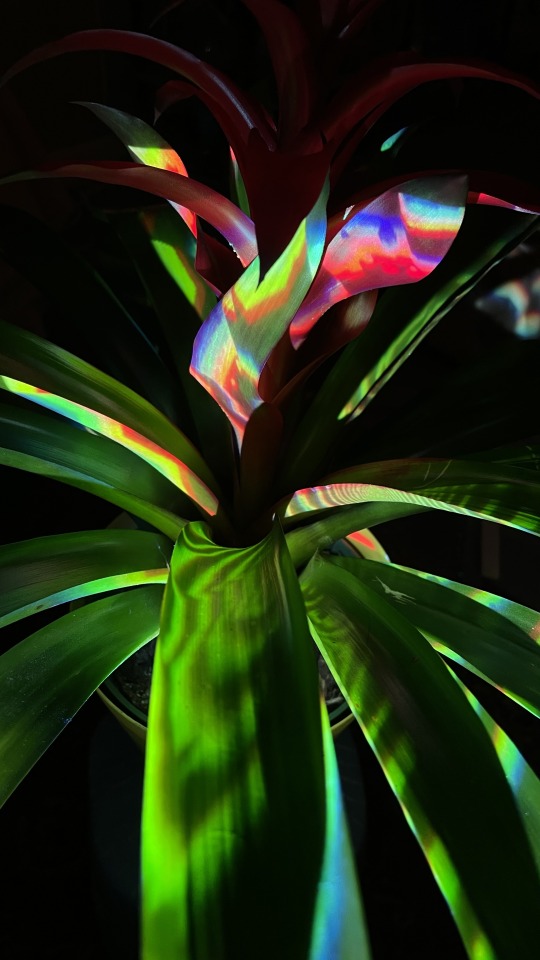
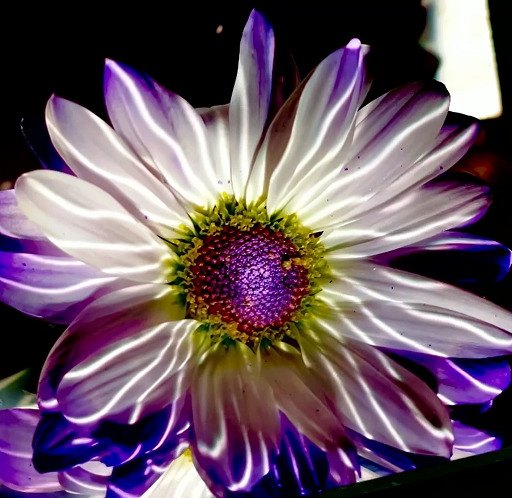

I'm not sure why I stopped - maybe life got in the way, and maybe I had bigger concepts (in terms of spaces) in mind. But I always meant to get back into it. It wasn't until I actually saw another artist's work that a friend shared with me that was executed beautifully, that really lit a fire under my ass. So I made it the utmost importance to buy some flowers.
What sets this new series apart from the artist's work I saw, and my previous work with plants and lights, is the intentional meaning behind ikebana. With this traditional Japanese floral arrangement, flowers aren't just placed in a vase - it's a meditation. The meditative practice of creating harmonious, visual forms with the flowers. Almost like sculpture and poetry combined. So I tried different combinations, tried to create a unique shape. Then complimented it with light.
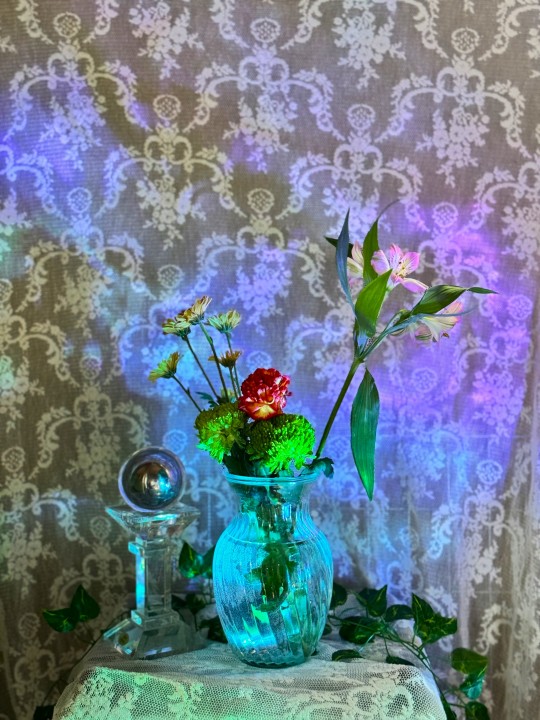


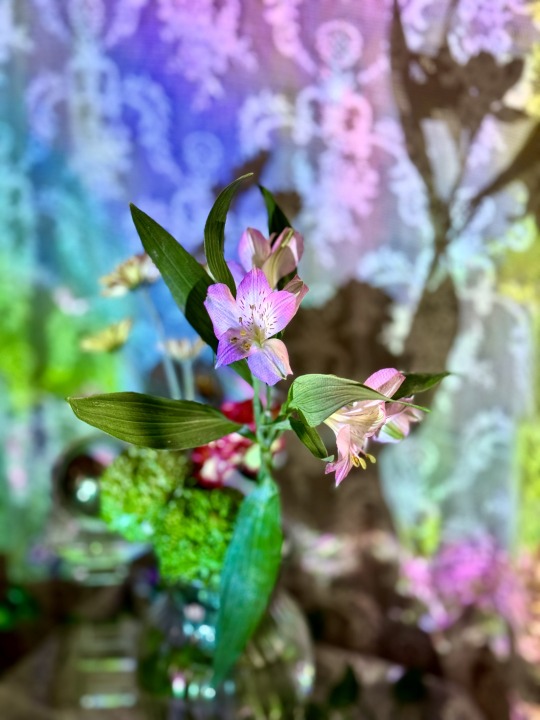
I used some animated projections I’ve made, as well as LEDs and iridescent light play. And it's the first of many.
#ikebana#floral art#floral aesthetic#floral arrangement#light art#light artist#projection#projection artist#light installation
4 notes
·
View notes
Text
Fortunes and symbols
As a conceptual artist, I like to think my work is focused more on abstract ideas and not so much on symbols. However, I do find symbols fascinating, and at times, powerful. A few years ago, I created a "tag" which I'd refer to as a "portal" tag in which it metaphorically would open a portal wherever it would be drawn. It's meant to be playful, albeit a bit juvenile. But it was then that I started to give it more meaning, and weight. Just the energy and focus given to it, pronounced it more. I suppose that's how most symbols work.
Around the same time, I got into oracle and tarot cards. All in line with divination, astrology, mysticism - more of a personal endeavor rather than a creative one. But it did become somewhat of a ritual.
I realized I started to give weight to these cards, symbols with meaning. I thought of creating my own deck - but just flirted with the idea. It seemed too ambitious.
Until recently, I was a part of a group show that was "casino themed." My work didn't quite fit the theme but I wanted to create an interactive part of an installation that would fit the theme - and I came up with my own fortunes. I just started off with 8, and I chose symbols that just came to mind naturally. A spiral for a portal, a sun, a waterfall. Easily recognizable imagery, and ones that not just resonate with me but I believe would resonate with others.
Then I started assigning meaning to each of these symbols, in the form of a fortune. I wrote out each blurb with intention for the receiver.
On the night of the show, I incorporated these fortunes into a game. I had a spinning wheel with each symbol and name drawn on a different sliver of color (rather crudely.) I had poker chips in which a person would buy a chip in relation to the color of the fortune they desired and gambled for. Each was given a certain amount of spins to win their fortune, some with a prize.
I'd say about 90% of players won the fortune they wanted. I then read it to them, and gave it to them.
It was a very fun and fulfilling experience, to interact with people in this way for the first time. This would definitely be a project to expand on, maybe not so much in the form of a gambling game but maybe in a card deck, who knows. I do think 8 cards is too little to be a deck, I'd have to do some more research on how to expand it, conceptually and design wise. It's a good start.


2 notes
·
View notes
Text
Pipilotti Rist in Chelsea, 2/2024
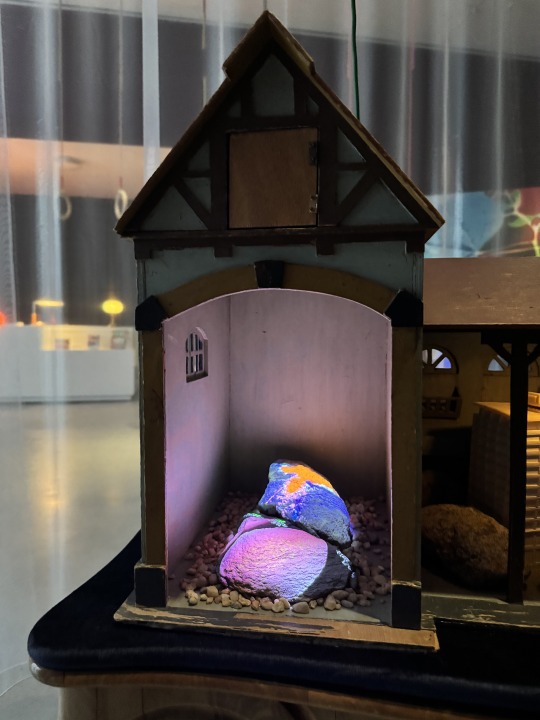

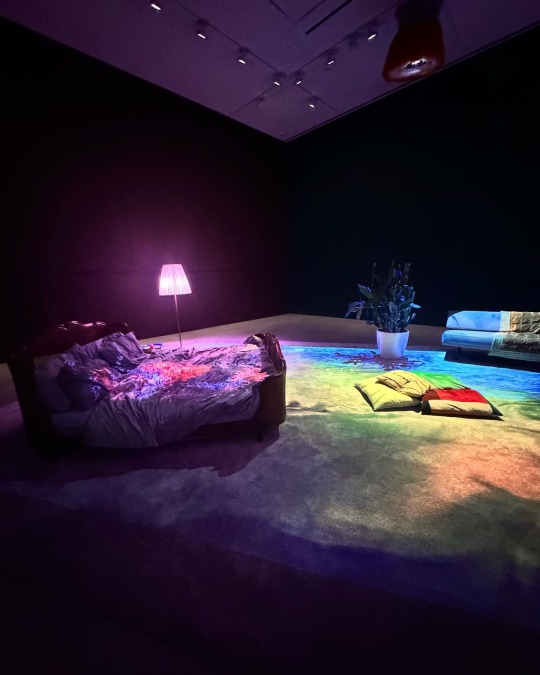


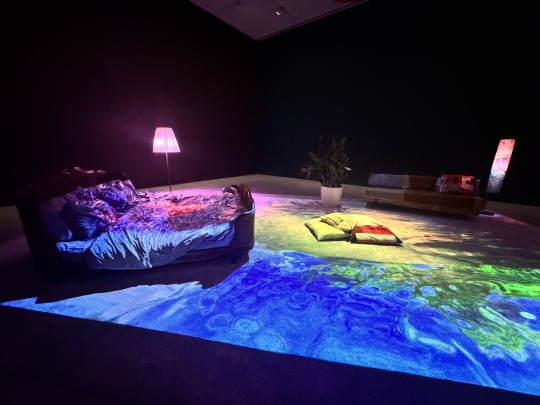
Choosing to be an installation artist, there are few artists to look to for inspiration in that path. For painters, you have the entirety of art history at your disposal. You even have time periods and styles to choose from - realist, abstract, surrealist. An an illustrator, same ball park. Sculpture, you get the idea. Installation art, moreover light installation art, we have from the Light and Space movement of the 1960's. Some would argue, and I'd agree with them, perhaps as far back as Thomas Wilfred, with his Lumia inventions of organs and analog light movements. Those are quite impossible to witness in real life, but we do have Dan Flavin's hypnotic fluorescence and James Turrell's mesmerizing projected color spaces. (Will definitely dedicate a post to those experiences.)
We also have the liquid light projectionists of the 60's and 70's, who are light artists and scientists and magicians in their own right - but can only be experienced when accompanied to a musical act. (Although they are indeed making a comeback outside the venues, as well as analog glitch video artists.)
But even with Flavin and Turrell, as inspirational and astounding their work has been, it almost seemed a bit untouchable to me. Like, if I wanted to paint an Impressionist landscape I can run down to the Met, stare at his gardens and seascapes for as long as I need to, and that would be the motivation I need. Flavin is a bit more consummable but Turrell's work is the complete opposite. You're left more in awe with the mystery of it all. It's more of a feeling, a reaction, an experience - quite hard to replicate. Which is, I'm sure, the point.
In my work, I'd say my paint brush is the projector. i started using projections in my work as a BFA photo student because I felt print and the monitor was too limiting. I needed the image bigger, more inviting. But soon the projection had a mind of it's own. I started noticing the strength of it's luminosity and how it reacted to different surfaces. I loved that it could be abstract or still display recognizable images. I started to remove the white wall altogether, projecting on objects like plastic, glass, fabric. Letting the projection bend and skew, letting it drape over everyday projects. I was a bit shunned in grad school for this method because I wasn't actually making any sculptures with my hands, to the dismay of the sculpture mentor. He had a colorful array of names to describe my installations such as "haphazard", "kitsch" and "tchotchke."
However, it was when I saw Pipilotti's work at MoMA PS1 a few years ago, I was enthralled. She had projections, videos she took documenting little details of life, herself, like a visual moving diary. And it was all projected on different surfaces; there were pillows on the floor to gaze up at the ceiling and watch the projections dance. She had an installation of just underwear. These were all everyday objects that were transformed, living spaces, interiors, made to be something different.
The same way I felt that day was the same way I felt a few weeks ago when I experienced her work again. Just like then, she had whole installations of found objects, memorabilia, tables, plants, glass bottles, fabric. And projections to accompany them all in unique and clever ways. One sculpture in particular was contained in a small wooden box that also acted as a home to the projector itself, hidden, to projection map on small rocks. From the small projections to the large room with projections on a bed and on a rug, she found a way to let us into her world, into her mind.
It was more than inspiring, it was affirming - that my methods for creating light art experiences are valid. Of course any artist can always be more skilled in any capacity, but I don't necessarily have to create my own light fixture to impress anyone; I don't have to world's fanciest, most expensive technology, or the greatest knowledge of coding to get my concept across. I can use what I have, and that's enough. More than enough - the possibilities with a room, a projector, and a few objects are endless.
#lightinstallation#light installation#light art#light artist#installation#installation art#pipilotti rist
3 notes
·
View notes
Text
Prism Gardens - a conceptual writing project
I haven't typed in an online blog post in probably, 10 years. I've typed emails, project proposals, cover letters, grants, but never just to type. I already feel good. It's nice to have the fingers flow for just pure expression and not for some reason to ask for a job or money. I write in my journals of course, but after a few pages it does get tiresome.
I wanted a place to talk about my process for making art, sharing my conceptual ideas, collaborations, thoughts on art I'm seeing and how it relates to my life. I suppose this place would be purely for me, but I won't have it be private in case there are people out there actually interested in those things, - in written form, atleast. Anyone can look at a tweet or instagram post/reel - does anyone read blogs anymore? Does anyone WRITE in blogs anymore? I'm about 20 years too late, I fear. Alas.
Prism Gardens.
As a multimedia light artist, which I fondly and loftily refer to myself, I use prisms in my work. My photographic work, my installation work, it's a big part of my practice. I guess I can say it's a relevant and consistent motif. Prisms perfectly encapsulate light, displaying refraction. Looking through them almost gives the eyes a new view of reality - distorting it, adding facets and layers in it's kaleidoscopic nature. The prism represents my approach to art making. Not only do I play with light and discover its capabilities, I would also say I distort, bend, offer and alter different realities through portals, dreamscapes, memories.
And that's just one prism! We're talking gardens, now. We're talking a space for many of these magical objects to flourish, display dazzling scenes of light while sharing doors into new worlds of inspiration, thought, and innovation.
I'm not sure this blog will reflect such magnificence, but it will certainly be an outlet for the process of it all. And the process isn't just for making art, but teaching, curating, and collaborating - things that all make up who I am as a creator, educator, curator, etc. (lover, poet, magician, scientist, etc...)
I think writing about my process in depth will help me understand myself more as an artist, my contribution to society, my goals and dreams; it will serve as a manifestation tool.
At the very least, it will have me be off my phone, so I'm already winning.
3 notes
·
View notes